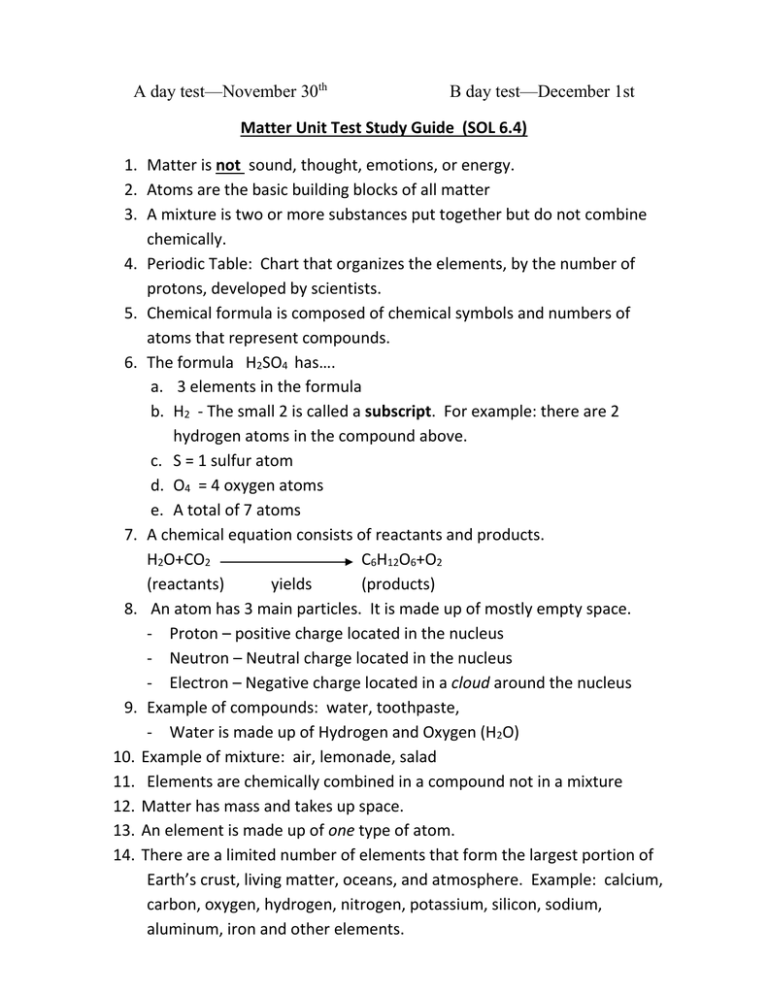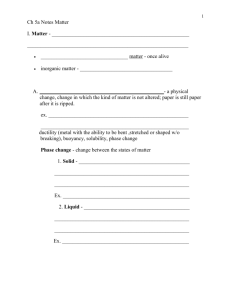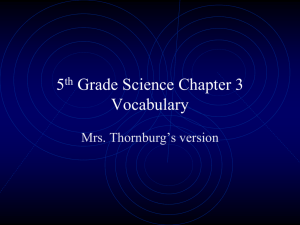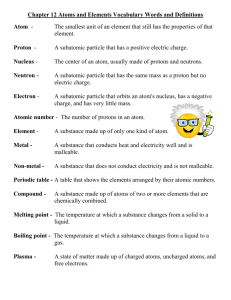Matter Unit Test Study Guide (SOL 6.4)
advertisement

A day test—November 30th B day test—December 1st Matter Unit Test Study Guide (SOL 6.4) 1. Matter is not sound, thought, emotions, or energy. 2. Atoms are the basic building blocks of all matter 3. A mixture is two or more substances put together but do not combine chemically. 4. Periodic Table: Chart that organizes the elements, by the number of protons, developed by scientists. 5. Chemical formula is composed of chemical symbols and numbers of atoms that represent compounds. 6. The formula H2SO4 has…. a. 3 elements in the formula b. H2 - The small 2 is called a subscript. For example: there are 2 hydrogen atoms in the compound above. c. S = 1 sulfur atom d. O4 = 4 oxygen atoms e. A total of 7 atoms 7. A chemical equation consists of reactants and products. H2O+CO2 C6H12O6+O2 (reactants) yields (products) 8. An atom has 3 main particles. It is made up of mostly empty space. - Proton – positive charge located in the nucleus - Neutron – Neutral charge located in the nucleus - Electron – Negative charge located in a cloud around the nucleus 9. Example of compounds: water, toothpaste, - Water is made up of Hydrogen and Oxygen (H2O) 10. Example of mixture: air, lemonade, salad 11. Elements are chemically combined in a compound not in a mixture 12. Matter has mass and takes up space. 13. An element is made up of one type of atom. 14. There are a limited number of elements that form the largest portion of Earth’s crust, living matter, oceans, and atmosphere. Example: calcium, carbon, oxygen, hydrogen, nitrogen, potassium, silicon, sodium, aluminum, iron and other elements. 15. Symbols represent elements. Symbol W H O Pb K Fe Name Tungsten Hydrogen Oxygen Lead Potassium Iron 16. Identify the elements and number of atoms of each element and atomic structure for NH3 - 2 elements (Nitrogen and Hydrogen) H N H - 1 atom of Nitrogen H - 3 atoms of Hydrogen 17. Models are representations of things that are not easily observable. **Know the following vocabulary: Matter is anything that has mass and takes up space. A compound is matter that is made when two or more elements combine chemically, which are held together by electrical forces (bonds). An element is matter made up of only one type of atom. The periodic table is a chart that organizes elements by the number of protons in each atom. A chemical formula is symbols and numbers that tell what elements are in a compound and their ratios. A mixture are substances that are put together but don’t form a compound. A proton is a positively charged particle in a nucleus. A neutron is an uncharged particle in a nucleus. An atom is the basic unit of an element. An electron is a particle in an atom with a negative electric charge. An isotope is an atom of an element, but with a different number of neutrons.





